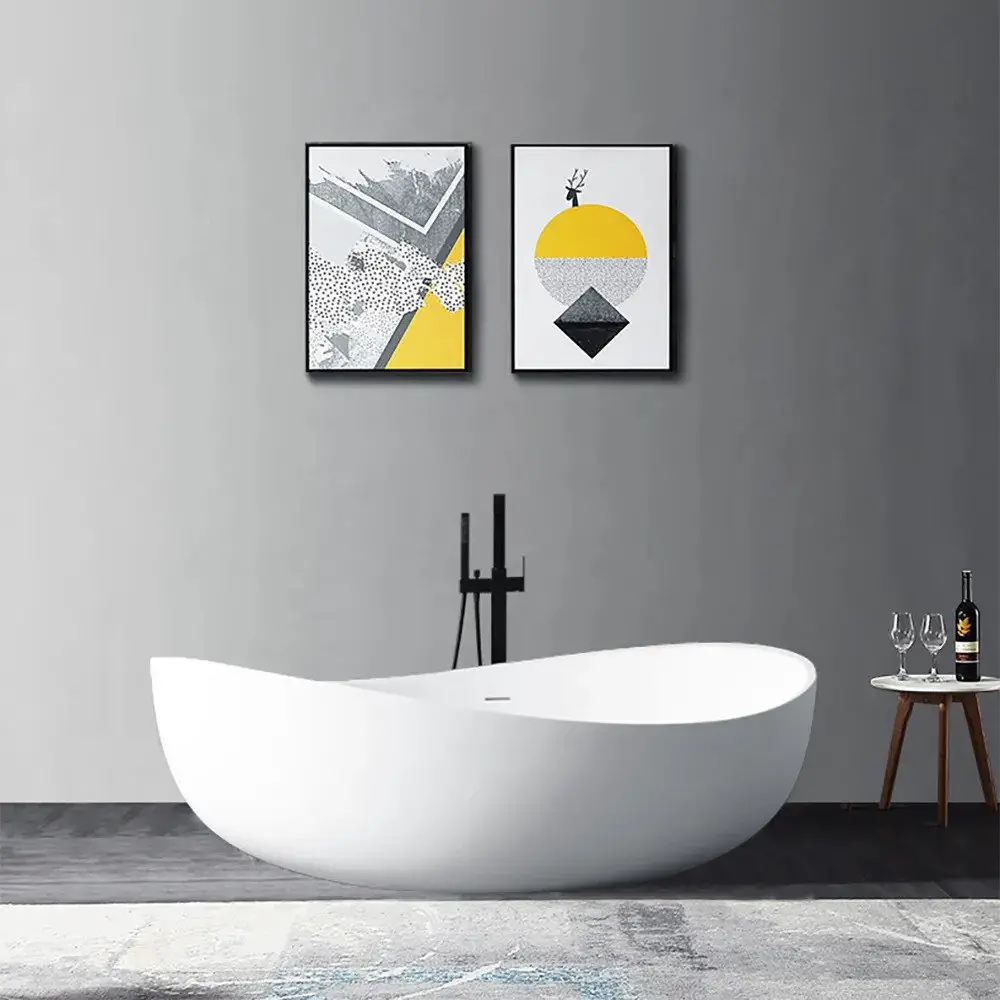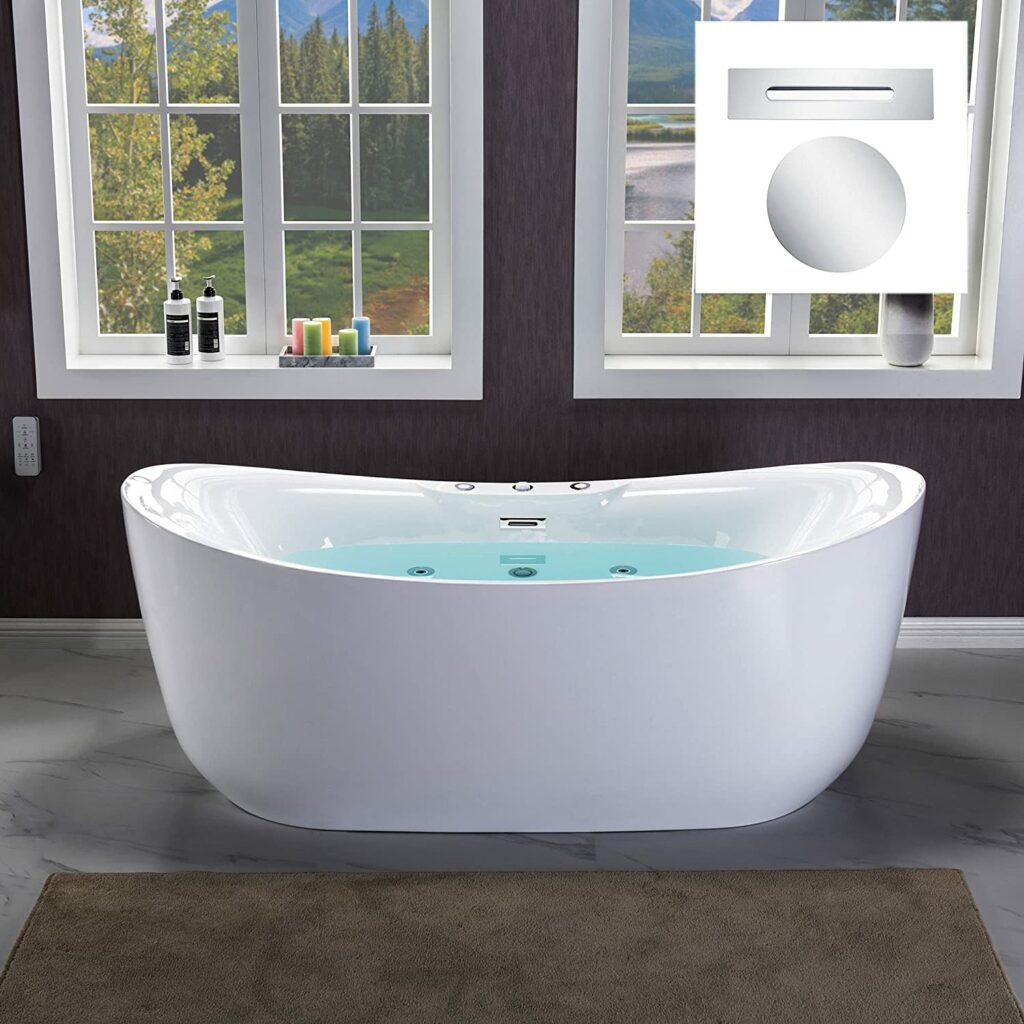The majority of people who use a bathtub regularly prefer freestanding tubs, as they come with many advantages compared to tubs that are attached to the wall or floor. However, this also means that freestanding tubs have their disadvantages, so it’s important to consider them before making your final decision.
Use links below for easy navigation
What is a Freestanding Tub?
Freestanding Tubs Pros and Cons
Freestanding Tub Pros
Freestanding Tub Cons
Freestanding Tubs Vs Drop-In tubs
Bottom Line
What is a Freestanding Tub?

A freestanding tub is a type of bathtub that is not affixed to the floor or wall of your bathroom. Instead, it’s simply placed on the ground and filled with water just like a traditional bathtub would be.
However, because freestanding tubs are not permanently affixed to your home, they’re ideal in certain situations, such as when you have limited space in your bathroom or when you want the option of installing a hot tub outside on your patio or deck.
Related: Best acrylic bathtubs
Freestanding Tubs Pros and Cons
If you’re in the market for a new bathtub, chances are you’ve considered both freestanding and built-in tubs, as well as large and small sizes. While each style and size offers unique benefits, choosing the right one can be overwhelming if you don’t know what to look for.
Whether you choose a freestanding tub or one that’s built into your bathroom, there are pros and cons to consider, including cost, durability, maintenance, and ease of installation.
Let’s take a look at Freestanding Tubs Pros and Cons.
Freestanding Tub Pros
The majority of people who use a bathtub regularly prefer freestanding tubs, as they come with many advantages compared to tubs that are attached to the wall or floor.
Flexibility
A freestanding tub can be placed in just about any space you want to put it in, as long as there’s enough room for it to fit. It’s also easy to move around if you need to make more room for other items, like a couch or a bed.
This type of tub comes in many different styles, shapes, and sizes so you can choose something that fits your needs perfectly.
Related: Best cast iron bathtubs
Design and Looks
A freestanding tub is designed with a clean, modern look that matches the rest of your bathroom. It has several appealing features that make it stand out from other types of baths on the market today including its modern look or classic style depending on what you want or need for your bathroom decorating ideas!
Freestanding tubs will complement the style of your home perfectly, whether it is contemporary or traditional.
Related: Marble bathtubs
Easy Installation
Freestanding tubs are easy to install—just remove the drain and install the base and overflow valve (if applicable). The base consists of two parts: a back panel and a front panel. This makes installation very simple because there’s less assembly required than with other types of baths
Related: Bathtub Drain Size
Perfect For Renovating Older Homes
Freestanding tubs look great and are easy to install! This makes them perfect for renovating older homes so that every room looks modern and stylish while still offering all of the functionality that comes with having a freestanding bathtub in your home.
Doesn’t block off the view of rest of the Bathroom
Freestanding tubs are an excellent choice for homeowners who want a tub that doesn’t block off their view of the rest of their bathroom. This can be especially important in smaller bathrooms or if you have a small space, as freestanding tubs can be placed anywhere within your bathroom.
Related: Most comfortable freestanding tubs
Soaking Depth
One of the biggest advantages of a freestanding tub is the amount of soaking depth it offers. The average soaking depth for a freestanding tub is about 10 inches. This means that you can get in and out of the water without having to move around, which can be both convenient and comfortable.
Related: Japanese soaking tub
Easy to clean
Another great thing about freestanding tubs is their ability to be cleaned easily. When you have an old-fashioned bathtub, it might take time for your drain and drain board to get clean after using them. This isn’t the case with a freestanding tub–you simply turn off the water, remove all of your attachments, and wipe down the surface with a cloth or sponge. It’s quick and easy! You can also use bathtub cleaners for this.
Comfortable to use
We’ve all been there, you’re at the end of your rope, and you need to take a moment to relax. You can’t just sit down in the bathtub, though—it’s too small. And if you try to sit stand up in the shower, you’ll also be uncomfortable.
That’s why we love freestanding tubs so much! They provide so much comfort and flexibility. You can soak deep into the water without worrying about how long it will take to get out, and they’re easier to clean than most other tubs.
When it comes down to it, freestanding tubs are just plain fun! They make it so easy to enjoy your bath time.
Related: Hammock Bathtub
Freestanding Tub Cons
The freestanding tub is a great choice for your home, but it does have some limitations.
Let’s take a look at freestanding tubs’ cons
Space
To start, it takes up a lot of space, which can make things like storage difficulty. It also requires a lot of maintenance and upkeep, so if you’re looking for an easy-to-maintain option, it might not be right for you.
Costly
The biggest downside to the freestanding tub is its cost, they tend to be more expensive than other types of bathtubs. This isn’t necessarily because they’re better quality—it’s just because they come with more features and options that make them more expensive.
Weight
A freestanding tub is heavier than most other types of bathtubs, so it may not be appropriate for someone who have trouble lifting heavy objects. If that’s the case, you should consider buying a smaller stand-alone tub that can be moved around easily.
Related: How much does a cast iron tub weigh?
No Shower Walls
Another issue with freestanding tubs is they don’t have shower walls, which means you may have issues with water overspill during your shower or other activities around the tub area.
Shower less
If this is something that bothers you, then consider buying one piece bathtub shower combo so that you can use it while standing up. However, be sure to check out our guide on how to get rid of showerheads when they’re no longer needed!
Plumbing
Another disadvantage is plumbing. This means that if something goes wrong with your plumbing it could potentially leak all over your floor or walls and create a big mess!
Make sure that before you purchase any type of freestanding tub you check out their plumbing system and see what kind of warranty they offer on their product so that if something does happen then they’ll replace whatever parts need replacing (and quickly!)
Storage
A freestanding tub is not really designed to be stored. It needs a place to stand, and that’s it. It doesn’t work well in small spaces, which is a problem if you want to put one in your bathroom.
Freestanding Tubs Vs Drop-In tubs
Freestanding tubs and Drop-In tubs are completely different from each other.
One of the biggest differences between freestanding and built-in tubs is that freestanding tubs can be used on their own without being attached to any other parts of your home. Built-in tubs have a specific place in your bathroom where they are often attached to the walls.
Freestanding tubs are great for when you have extra space. They’re also great if you have children and want them to feel like they’re bathing in the kitchen sink. Built-in tubs, on the other hand, are usually tucked away in corner or alcove, which is great if you have limited space in the bathroom but still want a bathtub!
Are freestanding tubs safe to use?
Freestanding tubs are completely safe to use. It could be hard for people with disabilities to get out of freestanding tub but for others it is completely safe to use.
How do I keep my freestanding tub from moving?
For keeping your freestanding tub in place, apply silicone on the bottom of the feet. Also make sure that all four feet are placed on secure surfaces such as tile or wood floors so that your tub won’t move around when someone gets into or out of it.
Is it hard to get out of a free standing tub?
It depends on the person, some people can easily get out of the freestanding tub while others find it difficult. If you have difficulty getting out then you may consider using a step stool or chair to assist you in getting out. Also, make sure your feet are dry before stepping out as water makes it slippery and more difficult for you to stand up straight.
How to keep freestanding bathtub from tipping over?
To prevent your freestanding bathtub from tipping over, make sure that its legs are level on all sides and that there aren’t any items stacked against it that could shift its center of gravity off-kilter if someone bumps into them while they’re in use.
How does freestanding tubs drain waste?
Most freestanding bathtubs have a drain plug in their floor so you can empty all of the water out when you’re done using it.
Bottom Line

Freestanding tubs are bathtubs that are constructed without the aid of support from your bathroom walls, instead relying on their own base to keep them upright.
Though they may seem intimidating at first, freestanding tubs have many benefits over their wall-mounted counterparts, such as increased flexibility in terms of where you can place them in your bathroom and increased safety, as well as being more convenient than traditional bathtubs.
If you’re looking for something unique and different in your bathroom design then the freestanding tub is definitely worth considering!


